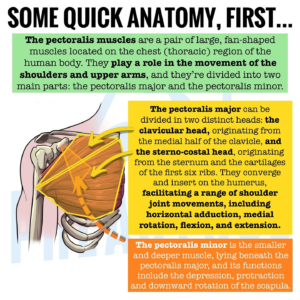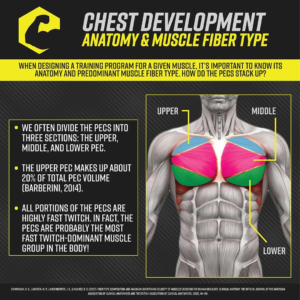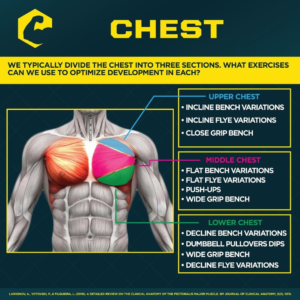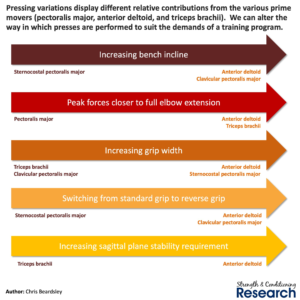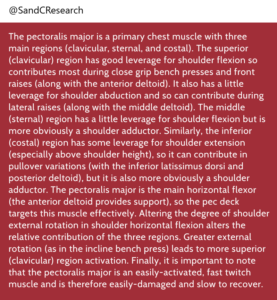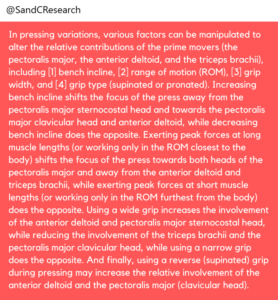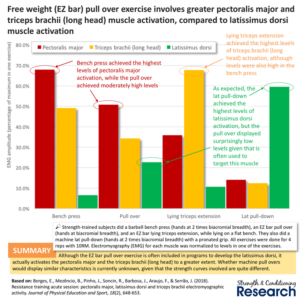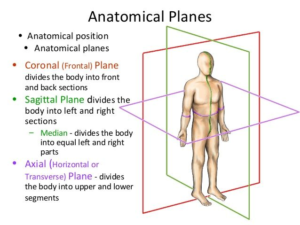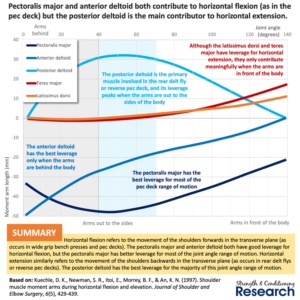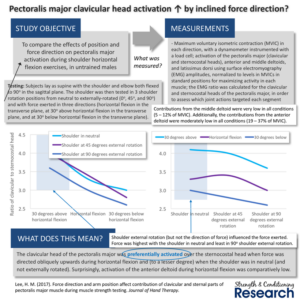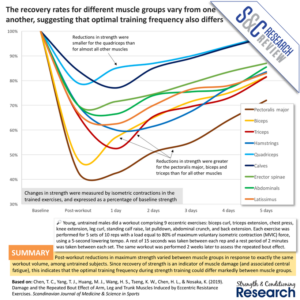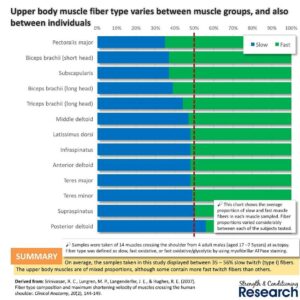PECTORALIS MAJOR – EXERCISES
Click on Image to Enlarge
TRAINING
- GRIP WIDTH
– a narrow grip increases involvement of the clavicular region & the triceps
– a wider grip increases involvement of the pec major sternal and costal regions & anterior deltoid - BENCH ANGLE
– a decline angle increases involvement of the pec major sternal and costal regions & triceps
– a flat angle works the entire pec major
– an incline angle increases involvement of the pec major clavicular region & the anterior deltoid - ROM – RANGE OF MOTION – PRESSING
– closest to the body emphasizes the entire pec major clavicular, sternal, costal regions
– farther from the body emphasizes triceps & anterior deltoid
PECTORALIS MAJOR – REVIEW
– including Moment Arm Studies
Pectoralis major – Beardsley
– Many muscles have multiple regions that can be trained with different exercises, according to their internal moment arm lengths.
– The three regions of the pectoralis major have different origins but similar insertions on the humerus, much like the latissimus dorsi.
#1. Internal Moment Arm Lengths – Sagittal and Frontal Planes
– These regions have different internal moment arm lengths from one another
– According to the principle of neuromechanical matching, this means that the regions will contribute differently to different exercises and movements.
A. Superior (clavicular) region: originates on the medial half of the clavicle; has good leverage for shoulder flexion
B. Middle (sternal) region: originates on the lateral side of the sternum; mainly a shoulder adductor but can also contribute to shoulder flexion
C. Inferior (costal) region: originates on the anterior sides of the upper six ribs; mainly a shoulder adductor but can also shoulder extension above shoulder height
#2. Internal Moment Arm Lengths – Transverse Plane
– The pectoralis major contributes to horizontal flexion (horizontal ad-duction) in the transverse plane, as well as to movements in the sagittal and frontal planes.
– However, the anterior deltoid does also provide some support in this movement.
#3. Direction of Force Production
– Historically, it has often been argued that the direction of force application during pressing movements can alter the relative contributions of the various regions
– Altering the direction of force application during horizontal flexion (horizontal ab-duction) ex: incline, flat, and decline bench presses
– Altering the degree of shoulder external rotation (inclined bench press), the superior (clavicular) region is more strongly activated
#4. Recovery Capacity
– The pec major recovers more slowly than most other muscles, even though it is not typically a muscle that often experiences a great deal DOMS
– This is a good example of why using DOMS to infer recovery status is not particularly helpful.
– This suggests optimal training frequency for a given amount of workout volume will be lower than for workouts that target other muscle groups.
– The pectoralis major likely recovers slower than most other muscles due to the extremely high proportion of fast twitch muscle fibers
– Fast twitch muscle fibers are more easily damaged after exercise because they have fewer mitochondria.
– Thus, they experience greater damage from the calpains (proteases) that are released in response to the influx of calcium ions during exercise.
#5. Stability
 – machine exercises and push ups involve much more stability than free weight bench presses, even though the movement pattern itself is very similar.
– machine exercises and push ups involve much more stability than free weight bench presses, even though the movement pattern itself is very similar.
– the anterior deltoid is a prime mover that provides stability in the sagittal plane, and therefore it is more active in the free weight bench press than in the push up.
– Which direction requires stabilization (sagittal plane or frontal plane) probably affects which muscle is called upon to provide stability.
